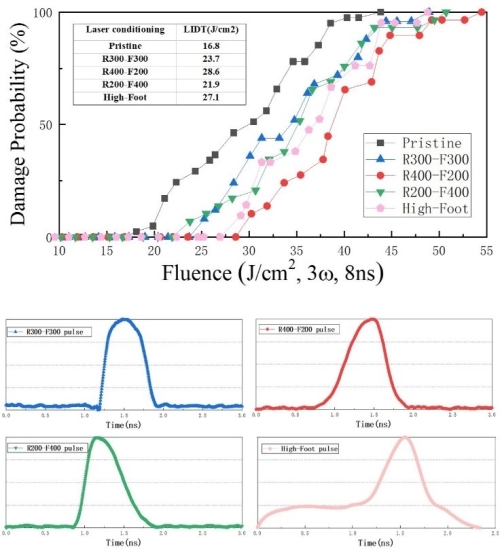Recently, researchers from the Laboratory of Thin Film Optics in Shanghai Institute of Optics and Fine Mechanics innovatively proposed a scheme to optimize the laser conditioning effect based on temporal shapes of the pulse, and studied the laser conditioning processes by using sub-nanosecond laser pulses with different combinations of rising and falling edges. The related achievement has been published in Optics Express on Oct. 25, 2021.
DKDP(KDxH(2-x)PO4) crystal is the only nonlinear optical crystal material served in ICF(Inertial Confinement Fusion). However, the laser induced damage of DKDP crystals seriously restricts the service life of components and the laser output. Laser condition is one of the methods that can effectively improve the laser induced damage resistance of DKDP crystals.
In recent years, many scientists have found that the pulse width of conditioned laser (especially in the sub-nanosecond range) has a great influence on the improvement of laser conditioning effects. By optimizing the sub-nanosecond laser parameters, DKDP crystal can obtain higher laser induced damage resistance.
After a series of experiments, researchers found that the speed of rising front has obvious influence on the conditioning effect of DKDP crystals, and the conditioning effect of sub-nanosecond laser with slow rising pulse front is 20% higher than that of Gaussian sub-nanosecond laser. Moreover, the damage morphology also changed obviously, showing local micro-cracks, which indicated that the sub-nanosecond laser conditioning with slow rising pulse front could carry out more thorough thermal modification on the precursors in DKDP crystals, and better improve the laser induced damage resistance of the crystal.
This research can provide important ideas and references for the research and improvement of laser induced damage properties of DKDP crystals and other nonlinear optical crystals.
The related work was supported by National Key R&D Program of China, National Natural Science Foundation of China, Strategic Priority Research Program of the Chinese Academy of Sciences and CAS special research assistant project.

Fig. 1 R-on-1 laser-induced damage thresholds of DKDP crystals before and after laser conditioning with different temporal shapes. (Image by SIOM)

Fig. 2 Nanosecond laser-induced damage morphologies of DKDP crystal after sub-nanosecond laser conditioning with different temporal shapes. (Image by SIOM)
Article website:
https://doi.org/10.1364/OE.441918
Contact:
WU Xiufeng
General Administrative Office
Shanghai Institute of Optics and Fine Mechanics, CAS
Email: xfwu@siom.ac.cn
Web: http://english.siom.cas.cn/